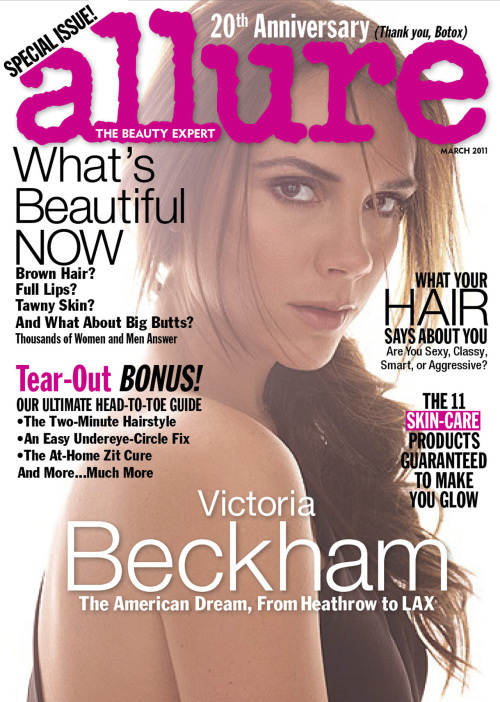Allure magazine finds broader beauty ‘ideal’ after 20 years
By 김후란Published : March 2, 2011 - 18:46
NEW YORK (AP) ― In the two decades since its launch, Allure magazine has tracked an evolution of the American definition of beauty. Surprisingly ― although it really shouldn’t be considering the changing collective face of the country ― is that the public is more accepting of a variety of ideals.
There is not the blond bombshell mold that everyone has to fit in to be considered attractive, either by oneself or others, says editor-in-chief Linda Wells. You can be old or young, dark skinned or light, slim or voluptuous, she says.
For its 20th anniversary issue in March with Victoria Beckham on its cover, Allure conducted a “beauty census,” showing photographs of models of different races and ethnicities to 1,000 men and women.
“We anticipated that the whole beauty ideal has changed, but the results are really different from the results 20 years ago,” Wells says. “It’s not blue-eyed blond anymore, it’s a woman of mixed race, dark hair, darker skin, she’s more voluptuous with a bigger butt and a flat stomach ― not that easy to do, thank you very much.”
But people understand that even this new, more diverse image isn’t attainable by the masses, she says, and that’s what makes it aspirational. “It wouldn’t be the ‘ideal’ if it was the everywoman.
Models are younger, thinner and prettier than the everywoman because they are models. But what’s interesting is the underlying social commentary that while the value people place on being beautiful has increased ... there is a wider range.”
There is not the blond bombshell mold that everyone has to fit in to be considered attractive, either by oneself or others, says editor-in-chief Linda Wells. You can be old or young, dark skinned or light, slim or voluptuous, she says.
For its 20th anniversary issue in March with Victoria Beckham on its cover, Allure conducted a “beauty census,” showing photographs of models of different races and ethnicities to 1,000 men and women.
“We anticipated that the whole beauty ideal has changed, but the results are really different from the results 20 years ago,” Wells says. “It’s not blue-eyed blond anymore, it’s a woman of mixed race, dark hair, darker skin, she’s more voluptuous with a bigger butt and a flat stomach ― not that easy to do, thank you very much.”
But people understand that even this new, more diverse image isn’t attainable by the masses, she says, and that’s what makes it aspirational. “It wouldn’t be the ‘ideal’ if it was the everywoman.
Models are younger, thinner and prettier than the everywoman because they are models. But what’s interesting is the underlying social commentary that while the value people place on being beautiful has increased ... there is a wider range.”

Also, Wells adds, people are more interested in improving on their own assets instead of mimicking what models do. There is also an emphasis on a “natural look,” even if that takes time to achieve. Women aren’t using heavy, matte makeup anymore, she says, favoring instead products with sheerer and thinner textures.
She does, however, miss the loyalty to perfumes that are largely gone. They gave a woman a signature, she says. “I miss the attention to fragrance. It has diminished in value in women’s lives. I miss the whole romance of fragrance. Women still buy it, but people change quickly and they don’t wear it every day.”
The biggest trend in the industry is anti-aging skin care, something that was only on the radar of “women over a certain age” back in 1991. Now it’s a way of saying you take care of your skin.
Now it’s synonymous with health in the way that sexy is a synonym with attractive,” she observes.
Use of sunscreens with higher SPFs ― so much so that people use it as part of their daily routine ― feeds into the healthy skin trend. “When we started the magazine, SPF 8 was the best-seller. Now you’d think it’s a joke ― you wouldn’t wear that to work on a cloudy day!”
Looking ahead, Wells predicts that consumers will further take quasi-medical procedures that used to be done in doctor’s offices into their homes, like they took teeth whitening from the dentist’s chair to their bathroom mirror. Could a wipe-on Botox or faux tan in a pill be far behind? She wonders.
These treatments might seem at odds with that more accepting, natural beauty ideal ― but not really, says Wells. “People don’t want to look like they’re trying too hard or that they’re uptight, yet we’re thinking about it more. It’s one of the wonderful contradictions of our society.”







![[Graphic News] More Koreans say they plan long-distance trips this year](http://res.heraldm.com/phpwas/restmb_idxmake.php?idx=644&simg=/content/image/2024/04/17/20240417050828_0.gif&u=)
![[KH Explains] Hyundai's full hybrid edge to pay off amid slow transition to pure EVs](http://res.heraldm.com/phpwas/restmb_idxmake.php?idx=644&simg=/content/image/2024/04/18/20240418050645_0.jpg&u=20240419100350)





![[From the Scene] Monks, Buddhists hail return of remains of Buddhas](http://res.heraldm.com/phpwas/restmb_idxmake.php?idx=652&simg=/content/image/2024/04/19/20240419050617_0.jpg&u=20240419175937)

![[KH Explains] Hyundai's full hybrid edge to pay off amid slow transition to pure EVs](http://res.heraldm.com/phpwas/restmb_idxmake.php?idx=652&simg=/content/image/2024/04/18/20240418050645_0.jpg&u=20240419100350)

![[Today’s K-pop] Illit drops debut single remix](http://res.heraldm.com/phpwas/restmb_idxmake.php?idx=642&simg=/content/image/2024/04/19/20240419050612_0.jpg&u=)